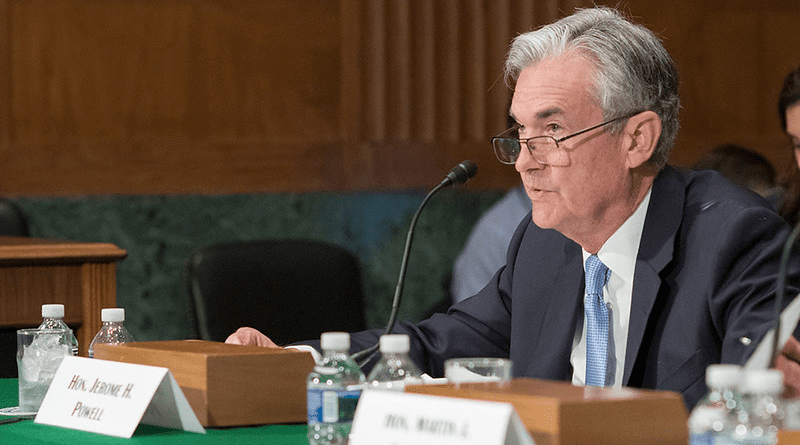Difficulty In Controlling Inflation Continues To Challenge The Fed – Analysis
By Anbound
By Wei Hongxu
The Federal Reserve chair Jerome Powell has recently issued a warning during a hearing with the U.S. Senate that the Fed’s policy interest rates and inflationary pressures may be higher than expected by policymakers.
Powell noted that recent trends suggest the Fed’s work in controlling inflation is not yet complete. “If the totality of the data were to indicate that faster tightening is warranted, we would be prepared to increase the pace of rate hikes”, he said.
This statement exceeded market expectations and implies that the magnitude and duration of interest rate hikes this year may exceed both the Fed’s and the market’s expectations. This also caused a significant drop in the U.S. stock market once again. The three major U.S. stock indexes collectively fell, with the Dow down 1.72%, the S&P 500 down 1.53%, and the Nasdaq down 1.25%. The U.S. dollar index rose by more than 1.2% to 105.6 compared to the previous day. Interest rate futures markets predict that the probability of a 50 basis point rate hike in March will be over 70%, up from about 31% just one day ago. These changes indicate that some previously optimistic expectations have been shattered in the face of harsh reality. Capital markets too, are reconsidering the impact of the Fed’s unexpected monetary policy on asset values.
After the Fed raised interest rates by 25 basis points in February, slowing the pace of interest rate hikes in the face of slowing inflation was a more certain trend. At that time, many market institutions were more optimistic, expecting that as inflation levels gradually fell, the Fed might start cutting interest rates later in the year after hiking rates to 5%, in order to achieve a soft landing for the U.S. stock economy. However, with the continuous updates of both inflation and employment data, both performances have been unexpected, which has forced the Fed to change its previous policy path and consider increasing interest rates again in March.
Researchers at ANBOUND pointed out not long ago that for the U.S., the “good news” in the economy is actually the “bad news” for inflation and capital market trends. The Fed will inevitably increase the amplitude and cycle of interest rate hikes, but there is still a long way to go in completely curbing inflation. Not only are market institutions overly optimistic in their estimates, but Powell also acknowledges that the current economic and inflation situation exceeds expectations. He said that data in January on employment, consumer spending, manufacturing production, and inflation partly reversed the economic weakness trend seen by the Fed in the data a month ago. The revision of last quarter’s data also suggests that inflation pressures may be higher than the FOMC’s previous expectations. So far, there is almost no sign of inflation easing in the core service sector other than real estate. To bring the inflation rate down to 2%, it is necessary to reduce inflation in the core service sector (excluding housing), and the labor market is likely to show some softening, according to Powell. He admitted that although nominal wage growth has slowed in recent months, it is still higher than the level corresponding to the 2% inflation target and the current output trend, noting also that “strong wage growth is good for workers, but only if it’s not eroded by inflation”.
Both short-term and long-term problems are posed by the issues of inflation and employment. If the Fed opts to increase interest rates to counteract inflation, economic demand will inevitably decrease, leading to a new equilibrium. The strong economic performance, combined with persistent inflation, is the current dilemma of the Fed’s monetary policy since last year. The stickiness of inflation and shifts in the structure of the U.S. economy make it more challenging for the Fed to regulate, and the probability of a soft landing is diminishing. Consequently, the U.S. economy will inevitably slide into stagnation, and may even plunge into recession.
The Fed’s policy rate is presently between 4.50% and 4.75%. According to the December dot plot, Fed officials expect this rate to rise to a peak of approximately 5.1%, but investors now anticipate this level to increase by at least 0.5 percentage points. Goldman Sachs has raised its expected peak rate range to 5.5%-5.75%, and BlackRock even foresees the Fed’s peak interest rate surpassing 6%. The continuous surge in interest rates is not only challenging for the U.S. economy to sustain but also detrimental to the global economy and capital markets. The persistent rise in the Fed’s policy rate will cause the U.S. dollar to strengthen, and the Chinese yuan has once again breached the key level of 7 per U.S. dollar. Other major economies will continue to confront pressure from interest rate disparities, and some high-inflation economies will also increase interest rates further. With the increase in global interest rates, debt problems, notably in emerging and underdeveloped countries, are more exposed to harm. Global capital markets will also experience the same turbulence that occurred last year.
Final analysis conclusion:
The modification in Federal Reserve Chair Jerome Powell’s outlook for U.S. inflation, along with his warning of potentially tighter policies, signifies that the U.S. inflation predicament has become arduous for the Fed to manage through monetary policy, compelling it to revert to the aggressive rate hikes strategy observed in the previous year. Such unexpected monetary policy tightening not only impedes the U.S. economy’s ability to evade the likelihood of stagnation or recession but also plunges the global economy and capital markets into a state of turbulence once again.
Wei Hongxu is a researcher at ANBOUND

